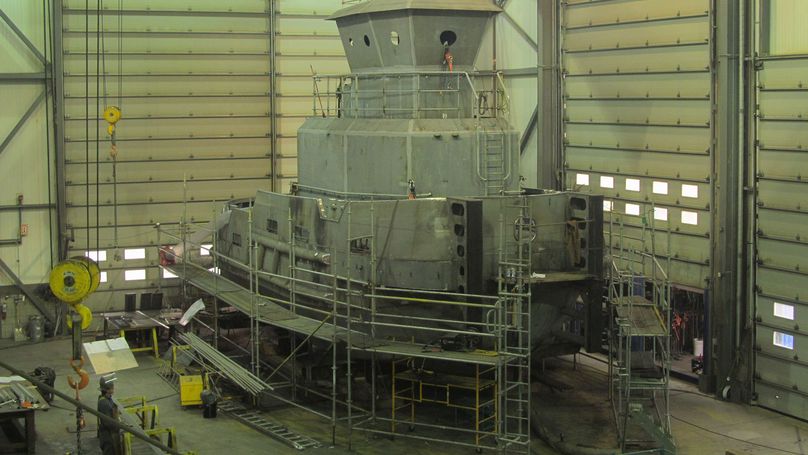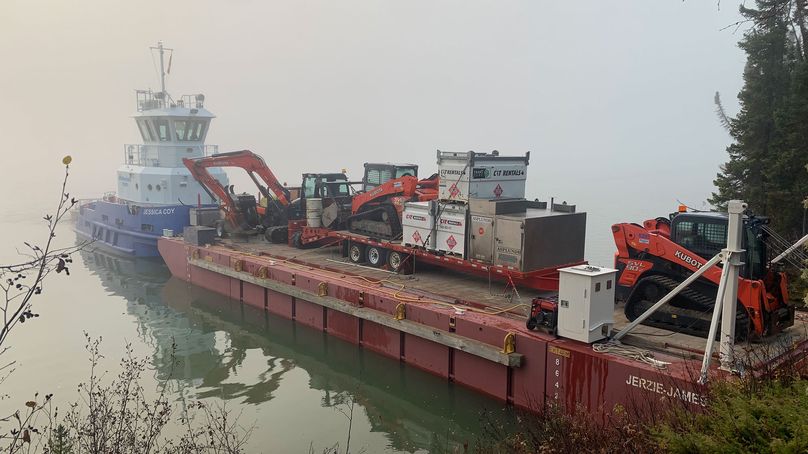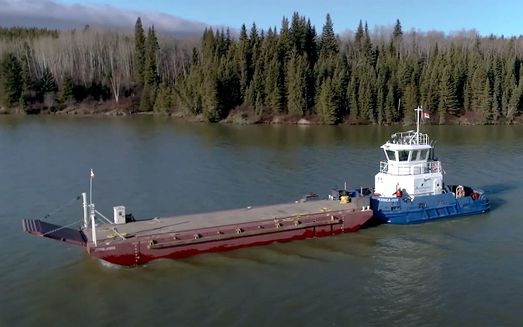A two-day journey on a tugboat through remote uncharted northern waterways may sound like an epic voyage fit for an explorer, but it’s just another day in the office for Hydro employees Dennis Bunn and Chris Hart.
Part of their job as the tugboat captain and deckhand is to ship critical equipment to Missi Falls Control Structure, which has no road or rail access.
The distance from Hydro’s dock at Notigi to Missi Falls is 241 kilometres. With an average speed of 12.2 km/h, it’s a two-day journey with one night docked in a bay or on an island along the way.
The Hydro tugboat and the one person licensed to operate it
A day on the water is a day in the office for our tugboat operators. In summer, they live and work on the tugboat that delivers critical Manitoba equipment through remote northern waterways.
Once at Missi Falls, the tugboat team spends the summer barging equipment between South Indian Lake and Missi Falls, like camp accommodations, fuel, and heavy-duty vehicles.
“Most people at Hydro probably don’t even know we have a tugboat, or what it’s used for,” said Dennis. “I didn’t know we had a tugboat until I was approached to operate it.”

DVD and Blu-ray library on the Jessica Coy tugboat.
Enlarge image: A TV and DVD collection inside the Jessica Coy tugboat.
The comforts of home
The tugboat is outfitted with sleeping quarters (sleeps four), a shower, and a kitchen and dining area. Not to mention an impressive DVD and Blu-ray collection.
“I’ve seen them all 10 times,” joked Dennis.
The captain
There’s only one person licensed to operate the tugboat at Manitoba Hydro, and that’s Dennis.
“I’m from Nisichawayasihk Cree Nation, born and raised in the north,” said Dennis. “My background was construction. I was a contractor – heavy equipment operator – during the Wuskwatim project. I graded the roads and did a number of things to keep the camp running,” said Dennis.
During the Wuskwatim Project, managers noticed his work ethic — and after the project wrapped up, he was approached to work for Hydro on the tugboat.
“I didn’t envision myself being a tugboat captain, but I saw it as a challenge, and here we are,” said Dennis.
He joined Hydro in 2015 (at the same time Manitoba Hydro got the Jessica Coy tugboat) and worked with the previous captain to learn the ropes. In 2019 he became the captain.
Chris Hart put in his first summer this year as the tugboat’s deckhand.

Seafarers Chris Hart and Dennis Bunn stand in front of their vessel, the Jessica Coy.
Enlarge image: Seafarers Chris Hart and Dennis Bunn stand in front of their vessel, the Jessica Coy.
Tugboat history at Manitoba Hydro
The Jessica Coy is not Manitoba Hydro’s first tugboat.
When the Churchill River Diversion’s construction finished in 1977, Manitoba Hydro kept the vessels used in construction and repurposed them as maintenance vehicles. Over the years, the fleet dwindled to just one operational tugboat, the Chemahaw, and a single barge.
Changes in Transport Canada regulation together with regular wear-and-tear meant Hydro needed to replace these vessels eventually.

The Jessica Coy tugboat in construction.
In 2015, Manitoba Hydro purchased the Jessica Coy. It was built specifically for Manitoba Hydro, arriving in five pieces and welded together in northern Manitoba.

The Jessica Coy tugboat in northern Manitoba.
Enlarge image: The Jessica Coy tugboat in northern Manitoba.

The Jessica Coy tugboat being assembled in northern Manitoba.
Enlarge image: The Jessica Coy tugboat being assembled in northern Manitoba.
Previous to the Chemahaw and Jessica Coy, Hydro also had the Workboy and the Athabascan tugboats.
All in a day’s work
All the barging to Missi Falls Control Structure is done over the summer while the water is thawed. With winter temperatures quickly approaching, the tugboat team completed the two-day journey back to the boat’s winter storage in Notigi in late October.
“Being a tugboat captain has its challenges, but at the end of the day when you get home and the crew is safe and you got the job done, I take a lot of pride in what I do,” said Dennis.





